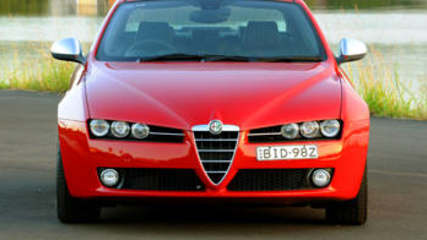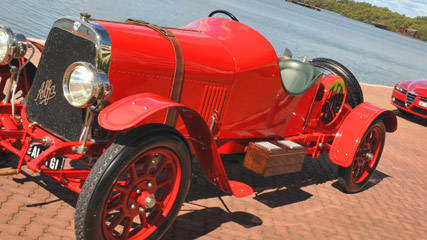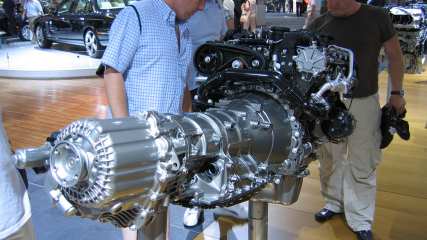Alfa Romeo 159 News

No prize for coming first
Read the article
By Paul Pottinger · 30 Apr 2009
The 159 came here in 2006 sans not only the automatic transmission option — crucial these days if you’re serious about attracting more than a few hundred punters (such as myself) — but also the refinement, efficiency, performance and various other things hoped for by those of us who, against all reason, hold Alfa Romeo in some regard.
Some embellishments and functional enhancements between first appearance and mid-life revision are par for the course, of course. Yet it’s the glaring improvement between model year 2008 and this one that’s so striking, so much so that if this were the work of Volkswagen they’d tell you it belonged to a new generation.
Put it this way, there’s far more substantive improvement between this year’s 159 (Ti editions and conventional ones alike) than has been claimed between the Mark V and Mark VI Golfs — not so much in terms of bits and pieces added on in, but for how the thing goes.
I drove the top-line diesel 159 this week over precisely the same bits of bitumen as every previous 159 to date. The five-cylinder turbo diesel is still far, far too gruff and loud for anything priced around $61K, but despite this and the same knee-weakening Giugiaro design and driver-centric cabin as before, you have a tough time believing it’s the same car.
Skinny Ti edition 19s notwithstanding, it rides the same bumps on which the last Ti in this garage just about scraped its chin off. Moreover, despite being dropped and stiffened it suffers altogether fewer instances of skittering and general ill-discipline.
All this without comprising the connectivity one feels with the road or that excellent turn in. And all that while channeling 400Nm through the front wheels.
Only 10 years ago, grown men were simpering in relief at having survived Saab’s manically torque-steering 9-3 Viggen with its 350Nm going through the pointy end. Yet the Alfa’s front-wheel nature comes to the fore mainly in terms of a bus-like turning circle.
The truly extraordinary leap forward, however, is Aisin’s six-speed automatic tranny. So maladroit was their previous effort it worked with the car about as harmoniously as a transplanted organ that the body is rejecting. Well, they’ve fixed it to the extent that it bears comparison with the benchmark ZF of BMW’s rival 320D.
There’s another car about which you might be entitled to feel sour if you’re among the first-up buyers. The BMW E90 – the fifth incarnation of the 3-Series — started life here with the previous generation’s 2.0-litre turbo diesel only to get the new, more efficient and faster engine in 2008, with further marginal improvements in output and efficiency for the 2009 range.
Says something doesn’t it?
All things really do come to he who waits.

1921 Alfa Romeo G1 a time machine
Read the article
By Paul Pottinger · 29 Apr 2009
...but fell through a sort of time warp and ended up, instead, in the cockpit of the oldest in existence.
Though its body and certain components cannot with conscience, or by connoisseurs, be called strictly authentic, the chassis, essentials and - dare we say? - heart and soul of the only 1921 Alfa Romeo G1 most assuredly is.
The only remaining of the 52 built, this glitteringly and hideously-expensively restored olde world roadster has spent much of the last decade of its almost 90 years occupying the foyer of Ateco Automotive, which has recently taken to importing Chinese econo-cars in addition to Italy’s best and proudest.
The showpiece and occasional joy toy of Ateco’s formidable head and super-maxi yacht owner and skipper, Neville Crichton, the G1 is literally priceless. As in, no-one’s quite sure what it’s worth. Just that it’s a hell of a lot and that handsome overtures to take it back ‘home’ to Italy have been soundly spurned.
Amid the sleek anonymity of modern driving devices, this leviathan is almost a visual scandal. After you take in its imposing, sunlight-blocking majesty, it’s the ‘missing’ things that make the greatest impression.
You reach for the door handle; there’s none. Nor a door. No roof, either, to protect the dark green leather should the heavens frown on this rare outing which Ateco mechanics take to keep the old banger’s vital fluids fluid.
Clambering way up and in – in itself no mean feat for the outsized citizen – you reach for the seat belt; not a one to be had. Check mirrors; the only reflection to be had is off the blazing red paint. Indicators? Try hand signals. Reach for the ignition key and there’s a starter pedal (and another to switch off) on the floor.
As to the pedals that drive this 2.6-tonne automated carriage, they’re arranged to further frighten the already nerve-wracked wretch sliding into the right seat (European cars were RHD back then) for his go. Some practical joker has configured it so the clutch is on the left (I can live with that), the brake to the outside right and the accelerator slightly below and in the middle. This too was the way, back in the day.
Oh, and the four-speed H-pattern gearshift is – even more quixotically from the modern perspective – hard up against your right leg, making for yet more counter-intuitive contortions.
Like most near-nonagenarians, the old beast takes a bit of enlivening first thing in the morning. Daryl, whose duties include trotting the G1 out from time to time, has to more than once unbuckle the thick leather bonnet straps and have a word with the whacking great 6.3-litre inline six. However, once up and away it’s remarkably refined, certainly not much less so than the five cylinder turbo diesel of the newest 159 Ti.
With Daryl having got us off the main road, I wipe damp hands on my car coat, and lurch forward. Grasping the silver stick, I grind my teeth and those of the unsynchronized transmission into second (“just shove it through”), ensuring that the stick ends up wedged under my leg – clearly the marque’s famously awkward driving position has early origins.
We putter with something approaching confidence along a long straight piece of road, stumbling when I cleverly apply the accelerator rather than the brake, until – oh, God – here comes a corner. Wrench that enormous steering wheel with the determination of Ahab helming through a cyclone (and to think how we moan about today’s over-assisted and feel free tillers) and arrrrrrround we go.
Easy when you know how. Except we’re in a cul-de-sac and a three-point turn must now be achieved. Indeed ‘achievement’ is the mot juste. When reversing, the steering loads up to about double its regular resistance; and with much crunching and shuddering this elementary manoeuvre is achieved with all the grace and dexterity of an elephant on roller skates.
Back on the straight and wide, we gain a bit of momentum, reaching a heady 30 miles per hour (50km/h) in fourth. Motorists of yore might have needed to travel distances with their mechanic in the passenger seat, but they surely knew driving in its rawest, most exhilarating and enervating form.
Of course, even if its mighty power-plant were never again to roar, the G1 would be an aesthetic triumph. Already eye-widening from without, it’s when you get within and examine the white-faced dials, the glittering metal and upholstery that you see the point of history at which the lingering elegance of the belle époque belatedly met the industrial age. Mere functionality was left to the likes of Henry Ford – the Italian prestige automobile had to be something more.
That this unique example endures is due not just to devoted restoration but to no little amount of good fortune. Prior to its acquisition by Crichton, the G1’s history was more checkered than a finishing flag.
Once of seven imported to Australia, this one was bought by a grazier near Winton who proceeded to become bankrupt. He might have lacked cash, but not wits – hiding the beauty on a neighbour’s property.
It was a smart move, foiled only by the grazier’s death three years later. So it was the Milanese aristocrat spent the depression powering a water pump in outback Queensland. Around 1947, cockies got the thing going as a paddock basher until the new owner undertook its first full restoration, using the G1 as a daily driver and on a regular commute between Brisbane and Melbourne.
Crichton collared it at auction in 1999, sending it to Christchurch for a ground-up restoration, where it acquired the current body. Its most notable outing was in 2005 under the auspices of Sydney car classicist and journo David Berthon, when it won its class in California’s ultra-prestigious Pebble Beach Concours d'Elegance.
Look, I don’t do nostalgia. I don’t pine for those good old days, which after even cursory research turn out not to have been very good at all, merely old (even at the time). But anyone who is not in the thrall of this singular experience – however brief – has lost the ability to be impressed.
I’m not an unfit fellow, but I’m simply in awe of those weedy little chaps who steered these mighty machines in competition. I mean: do Le Mans in something like this? Phew …
Back at Ateco, I slip into the 159 Ti, Alfa’s remarkable recent reinvention of its slow-selling midsizer.
Engaging drive (it’s still somehow difficult to grasp the notion of an automatic Alfa), I segue onto the rutted, ruined bitumen of a Sydney main road and head home among the variously inept and arrogant, but uniformly unschooled, motorists and muse that in terms of driverly sense, cars may have become cleverer, but we are surely dumber than those who drove in the era of the G1.

Australian Motor Show opening day part 2
Read the article
By Stephen Corby · 28 Oct 2006
Alfa Romeo stepped up straight after the Peugeot unveiling of a woman, I mean a car. A 207 apparently.
The master craft
Read the article
By Stuart Martin · 04 Apr 2006
One of the headline acts will be the French star of recent independent crash tests - the Citroen C6 - which has been acclaimed as the safest car yet tested by the New Car Assessment program.The C6, set to go on sale in Australia by the middle of the year, is the fi rst car to earn the maximum four stars from Euro NCAP for its pedestrian safety rating, as well as a maximum fi ve stars for occupant protection.It's also won an award as the world's most beautiful large sedan.The C6 is offering two V6 engines - a 2.7-litre 150kW turbo diesel or a three-litre 155kW petrol engine; both drive the front wheels via a six-speed automatic gearbox.Alfa Romeo's 156 range brought the Italian brand back to the fore in Australia with fl air and passion. It's replacement, the 159, continues in that tradition. It will offer more modern drivetrains - and even a V6 with Australian roots - when it hits the market mid year.Designed by Giorgetto Giugiaro and the Alfa Romeo Styling Centre, the new car will come in both front and all-wheel drive versions, with the Q4 permanent four-wheel drive system using three diffs to split drive.The Alfa Romeo 159 is the first of a whole family of new Alfas due over the next two years, including the Brera.Lexus will be the fi rst car maker to offer a luxury hybrid model, with its GS petrol-electric hybrid offering plenty of performance with the thirst and emissions of a two-litre.The Toyota-owned luxury brand also has a hybrid version of the RX SUV but the company's stand in Adelaide will feature the RX350 - which sees the looks get a nip and tuck, with a new more-powerful and more fuel-effi cient engine beneath its sculpted snout.When Volkswagen went back to the factoryowned subsidiary, they announced high hopes of surpassing 20,000 units by now. They haven't got there yet but with more than 15,000 sales last year the German car maker is on the right track.The prestige segment will see the Passat return with a vengeance this year, with direct-injection two-litre petrol and turbo-diesel engines, or a V6 petrol engine, on offer in either sedan or wagon body style.The sales have had a boost from the new Golf and the newly-introduced (and keenly-priced) Jetta, giving the German car maker plenty of ammunition to work with.Peugeot will give Adelaide show-goers a look at its new 407 Coupe, a sleek, powerful and attractive 2+2 that will be offered in petrol and diesel models on sale in Australia as the show opens.The coupe will be offered with a three-litre 155kW/290Nm V6 petrol engine with either a sixspeed manual gearbox or new six-speed automatic transmission for $65,990 and $68,190 respectively.The sleek Pug will also be offered with a 2.7-litre V6 HDi twin-turbo diesel offering 150Kw and 440Nm with a six-speed automatic gearbox as standard. It will be priced at $72,500.Porsche chose to introduce the Australian motoring media to the Cayman S in the countryside surrounding Adelaide and its fi tting the German brand returns to the motor show this year with the same model.The Cayman S is more than a Boxster with a roof, sharing inlet systems and some other nice bits with the 911.The bulk of the DNA traces back to the midengined Boxster, which gives the two-seater Cayman the same basic powerplant - although slightly larger - plus the superb road manners and balance that has made the convertible a popular option among Porsche buyers.Chrysler has returned to the Australian market with plenty of enthusiasm and some interesting product, the latest and most powerful example of that statement being the 300C sedan.Soon to be followed by diesel and wagon variants, the V8 300C has serious visual impact and packs plenty of equipment to take on the big locally-built luxury sedans.The Chrysler has the added attraction of displacement on demand, which drops fourcylinders from use to save fuel when light throttle loads are required.




